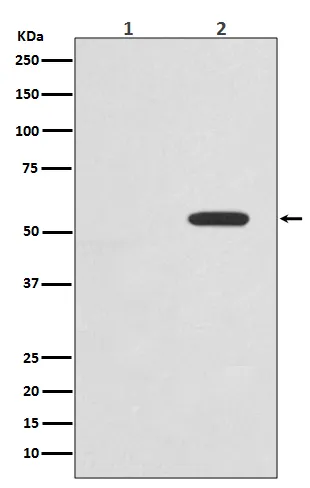
Size:100μL Price:$230
Size:200μL Price:$380
Application:WB,ICC/IF,FC
Reactivity:Human,Mouse,Rat
Conjugate:Unconjugated
Optional conjugates: Biotin, FITC (free of charge). See other 26 conjugates.
Gene Name:MYC
Summary
| Production Name | Phospho-c-Myc (T58) (1A2) Rabbit Monoclonal Antibody |
| Description | Recombinant rabbit monoclonal antibody |
| Host | Rabbit |
| Application | WB,ICC/IF,FC |
| Reactivity | Human,Mouse,Rat |
Performance
| Conjugation | Unconjugated |
| Modification | Phosphorylated |
| Isotype | IgG |
| Clonality | Monoclonal |
| Form | Liquid |
| Storage | Store at 4°C short term. Aliquot and store at -20°C long term. Avoid freeze/thaw cycles. |
| Buffer | Rabbit IgG in phosphate buffered saline , pH 7.4, 150mM NaCl, 0.02% New type preservative N and 50% glycerol. Store at +4°C short term. Store at -20°C long term. Avoid freeze / thaw cycle. |
| Purification | Affinity purification |
Immunogen
| Gene Name | MYC |
| Alternative Names | MRTL; MYC; Myc proto-oncogene protein; c-myc; |
| Gene ID | 4609 |
| SwissProt ID | P01106 |
Application
| Dilution Ratio | WB 1:500-1:2000,ICC/IF 1:100-1:200,FC 1:200-1:1000 |
| Molecular Weight | 49kDa |
Background
Myc a proto-oncogenic transcription factor that plays a role in cell proliferation, apoptosis and in the development of human tumors. Seems to activate the transcription of growth-related genes. Transcription factor that binds DNA in a non-specific manner, yet also specifically recognizes the core sequence 5'-CAC[GA]TG-3' (PubMed:24940000, PubMed:25956029). Activates the transcription of growth-related genes (PubMed:24940000, PubMed:25956029). Binds to the VEGFA promoter, promoting VEGFA production and subsequent sprouting angiogenesis (PubMed:24940000, PubMed:25956029). Regulator of somatic reprogramming, controls self-renewal of embryonic stem cells (By similarity). Functions with TAF6L to activate target gene expression through RNA polymerase II pause release (By similarity).
Research Area
Epigenetics and Nuclear Signaling
